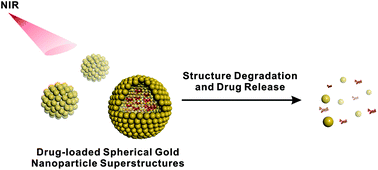Loading and triggered release of cargo from hollow spherical gold nanoparticle superstructures†
Abstract
Hollow spherical gold nanoparticle superstructures having different average diameters (∼75 nm and ∼150 nm) and near-infrared (NIR) extinction were prepared and loaded with an anti-cancer drug, doxorubicin (DOX). The stability of these structures and drug release was monitored in the presence of proteinase and upon irradiation with NIR light. Proteinase K promotes DOX release from the ∼150 nm superstructures and NIR light promotes DOX release from both the ∼75 nm and ∼150 nm superstructures.



 Please wait while we load your content...
Please wait while we load your content...